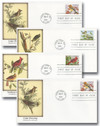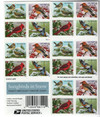
2016 First-Class Forever Stamp,Songbirds in Snow
# 5126-29 - 2016 First-Class Forever Stamp - Songbirds in Snow
$1.25 - $67.50
U.S. #5126-29
2016 47c Songbirds in Snow
One of the best methods scientists use to learn about songbirds is bird banding. After going through special training, researchers capture wild birds and place a small aluminum band on their leg. Each band is inscribed with a different number unique to that bird. If another person later captures the same bird, they simply record the band number along with the bird’s other data. The researcher then sends the information to the North American Bird Banding Program. This agency is responsible for regulating bird banding and is run by the United States Geological Survey and the Canadian Wildlife Service.
Bird banding is useful for determining how long different species live, how they are affected by environmental changes, what their migration patterns are, and much more. The North American Bird Banding Program collects and analyzes data annually. From 1960-2016, the United States alone has banded: 218,149 golden-crowned kinglets; 174,598 cedar waxwings; 490,531 northern cardinals; and 52,949 red-breasted nuthatches.
North America is a paradise for many songbirds. Thanks to bird banding, scientists can keep track of each species and begin conservation efforts if populations decline. As long as this program is around songbirds and their unique melodies will be too.
One of the best methods scientists use to learn about songbirds is bird banding. After going through special training, researchers capture wild birds and place a small aluminum band on their leg. Each band is inscribed with a different number unique to that bird. If another person later captures the same bird, they simply record the band number along with the bird’s other data. The researcher then sends the information to the North American Bird Banding Program. This agency is responsible for regulating bird banding and is run by the United States Geological Survey and the Canadian Wildlife Service.
Bird banding is useful for determining how long different species live, how they are affected by environmental changes, what their migration patterns are, and much more. The North American Bird Banding Program collects and analyzes data annually. From 1960-2016, the United States alone has banded: 218,149 golden-crowned kinglets; 174,598 cedar waxwings; 490,531 northern cardinals; and 52,949 red-breasted nuthatches.
North America is a paradise for many songbirds. Thanks to bird banding, scientists can keep track of each species and begin conservation efforts if populations decline. As long as this program is around songbirds and their unique melodies will be too.
Value: 47c
Issued: August 4, 2016
First Day City: Portland OR
Type of Stamp: First Class Mail
Printed by: Ashton Potter
Method: Offset
Self-Adhesive
Printed by: Ashton Potter
Method: Offset
Self-Adhesive
Quantity Printed: 600,000,000
U.S. #5126-29
2016 47c Songbirds in Snow
One of the best methods scientists use to learn about songbirds is bird banding. After going through special training, researchers capture wild birds and place a small aluminum band on their leg. Each band is inscribed with a different number unique to that bird. If another person later captures the same bird, they simply record the band number along with the bird’s other data. The researcher then sends the information to the North American Bird Banding Program. This agency is responsible for regulating bird banding and is run by the United States Geological Survey and the Canadian Wildlife Service.
Bird banding is useful for determining how long different species live, how they are affected by environmental changes, what their migration patterns are, and much more. The North American Bird Banding Program collects and analyzes data annually. From 1960-2016, the United States alone has banded: 218,149 golden-crowned kinglets; 174,598 cedar waxwings; 490,531 northern cardinals; and 52,949 red-breasted nuthatches.
North America is a paradise for many songbirds. Thanks to bird banding, scientists can keep track of each species and begin conservation efforts if populations decline. As long as this program is around songbirds and their unique melodies will be too.
One of the best methods scientists use to learn about songbirds is bird banding. After going through special training, researchers capture wild birds and place a small aluminum band on their leg. Each band is inscribed with a different number unique to that bird. If another person later captures the same bird, they simply record the band number along with the bird’s other data. The researcher then sends the information to the North American Bird Banding Program. This agency is responsible for regulating bird banding and is run by the United States Geological Survey and the Canadian Wildlife Service.
Bird banding is useful for determining how long different species live, how they are affected by environmental changes, what their migration patterns are, and much more. The North American Bird Banding Program collects and analyzes data annually. From 1960-2016, the United States alone has banded: 218,149 golden-crowned kinglets; 174,598 cedar waxwings; 490,531 northern cardinals; and 52,949 red-breasted nuthatches.
North America is a paradise for many songbirds. Thanks to bird banding, scientists can keep track of each species and begin conservation efforts if populations decline. As long as this program is around songbirds and their unique melodies will be too.
Value: 47c
Issued: August 4, 2016
First Day City: Portland OR
Type of Stamp: First Class Mail
Printed by: Ashton Potter
Method: Offset
Self-Adhesive
Printed by: Ashton Potter
Method: Offset
Self-Adhesive
Quantity Printed: 600,000,000













